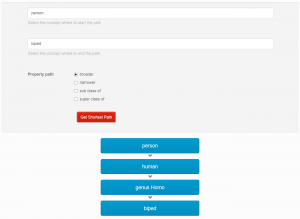| We just released a new UMBEL ontology graph analysis web service endpoint: the Shortest Path web service endpoint. |  |
The Shortest Path Web service is used to get the shortest path between two UMBEL reference concepts by following the path of a transitive property. The concepts that belong to that path will be returned by the server.
This web service is similar to the degree web service endpoint but the actual path is shown. This web service is (marginally more useful) than degree. So if you don’t need to know the actual concepts that participate in the shortest path between two concepts, then you should be using the degree web service endpoint instead.
The graph created by the UMBEL reference concepts ontology is a mostly an directed acyclic graph (DAG). This means that a given pair of concepts is not necessarily linked via all the properties. In these cases, the shortest path returns an error message rather than the path concepts.
Intended Users
This new web service endpoint is intended for users that want to perform graph/network analysis tasks on the UMBEL web service endpoint.
The Web Service Endpoint
The web service endpoint is freely available. It can return its resultset in JSON or in EDN (Extensible Data Notation).
This endpoint will return a vector (so the order of the results is important) of concepts that participate into the shortest path. For each concept, its URI and preferred label are returned.
The Online Tool
We also provide an online shortest path tool that people can use to experience interacting with the web service.
The user first needs to select the two concepts for which he wants to find the shortest path between the two. Then he has to select the transitive property he want to use to find the path.
Once the user clicks the Get Shortest Path button, he will get list of concepts, and the order, that compose the path.
If no path exists between the two concepts for the selected property, an error message is displayed to the user.

Tagging Web Documents with the UMBEL Taggers
Another improvement included with this release is the enhancement of the UMBEL taggers12. It is now possible to tag any document accessible on the Web. The only thing you have to do is to provide a URL where the tagger will find the document to download and tag.
The user interface for the taggers also was modified to expose this new functionality. You now have the choice to give a text or a URL as input to the endpoints:

Nasreddine
August 11, 2015 — 4:35 am
Hi,
I’m trying to use UMBEL ontology to calculate information based similarity between concepts. This similarity meature requires a DAG graph, which is not the case. I found cycles for example here :
http://umbel.org/umbel/rc/OntologicalEngineer — http://www.w3.org/2004/02/skos/core#broaderTransitive — http://umbel.org/umbel/rc/Person
http://umbel.org/umbel/rc/Person — http://www.w3.org/2004/02/skos/core#broaderTransitive — http://umbel.org/umbel/rc/HomoSapiens
http://umbel.org/umbel/rc/HomoSapiens — http://www.w3.org/2004/02/skos/core#broaderTransitive — http://umbel.org/umbel/rc/Person
Also I’m confused which relation to take into consideration to generate taxomony of concepts. You’ve cited that you use skos:broaderTransitive to create hierarchy between resource concepts. However, this relation sometimes transitive (includes even super concepts) and other-times is not.
Samething with rdfs:subClassOf relation or skos:broader.
I’m very confused which relation to take into consideration to construct taxonomical hierarchy of resource concepts ?
Frederick Giasson
August 13, 2015 — 11:00 am
Hi!
Yes there are cycles in the UMBEL hierarchy such as the one you pointed out. What you would have to do to make it a DAG is to detect these cycles, and to remove the triples that introduce them.
For the work you intend to do I think you should only consider the skos:broaderTransitive properties. It is not possible with skos:broader since it is not transitive. About rdfs:subClassOf it could work to, but only on the classes structure.
Hope it helps,
Thanks,
Fred